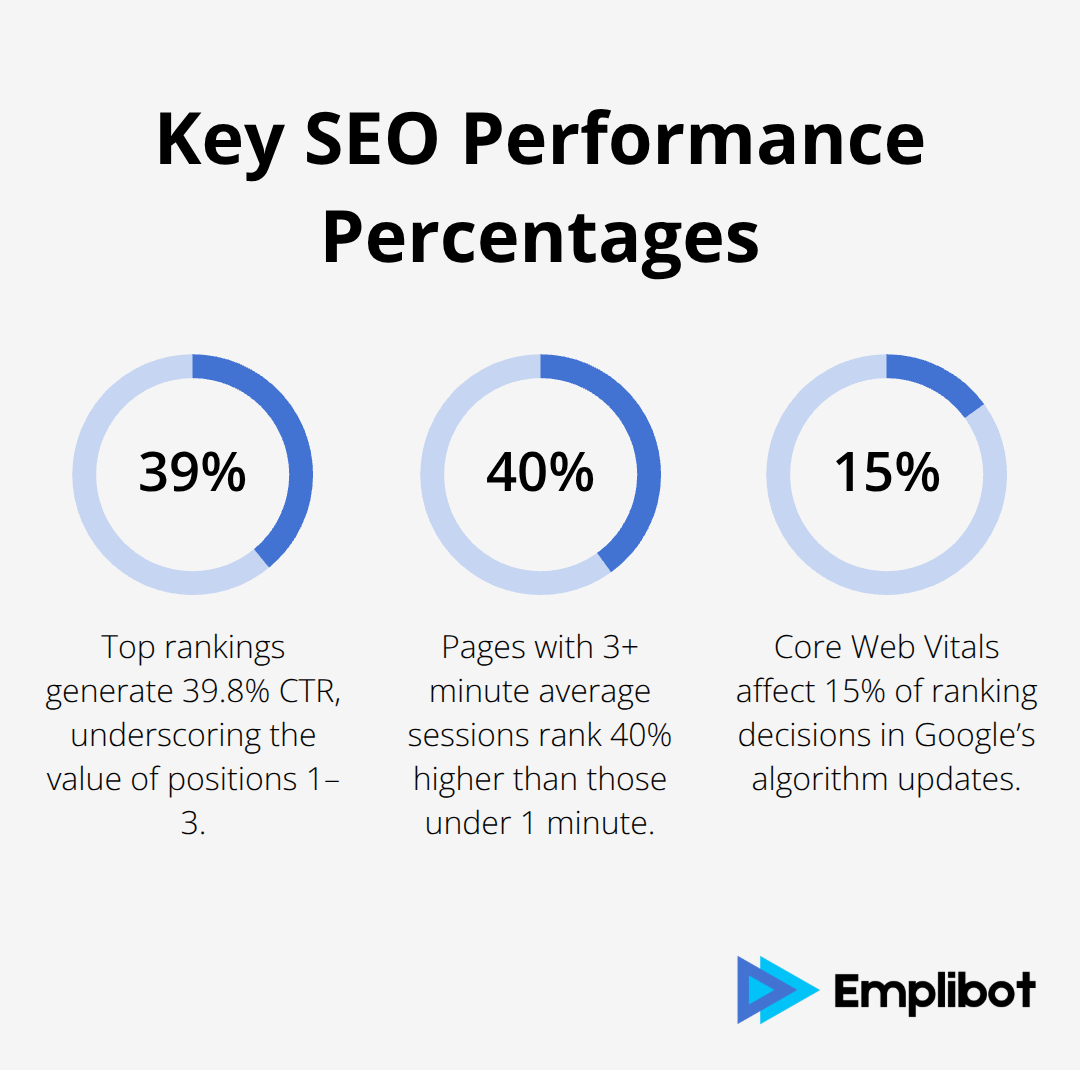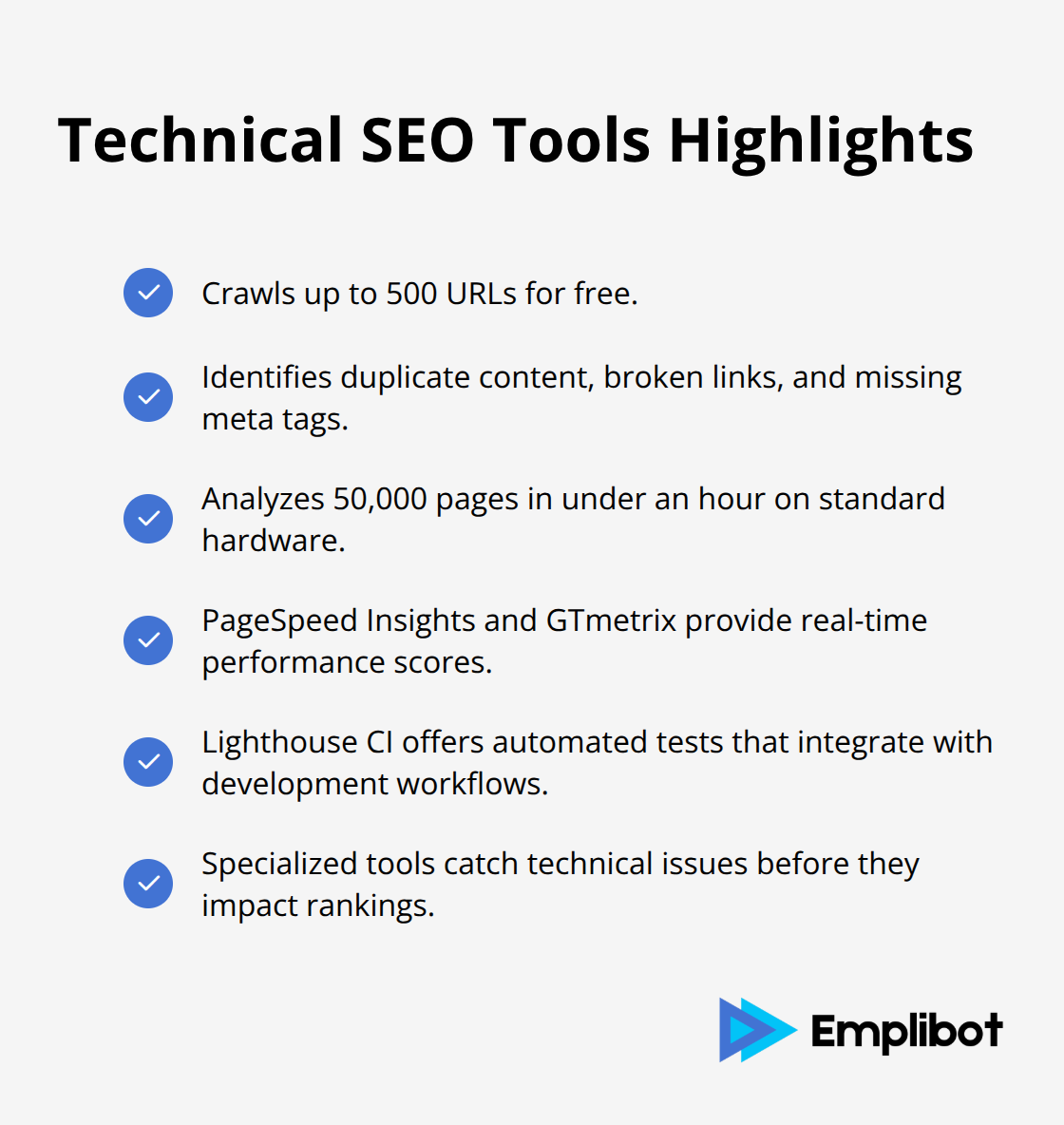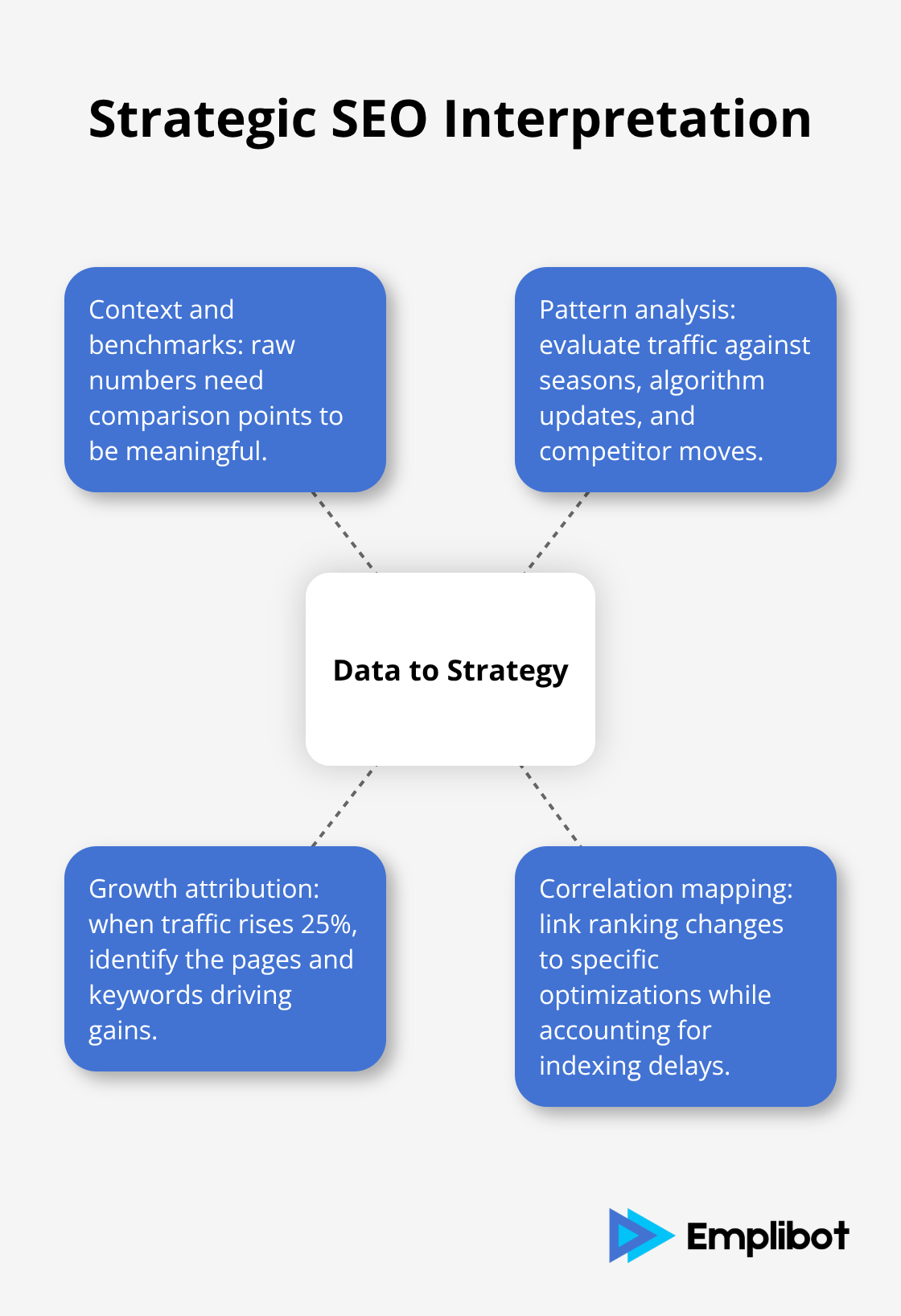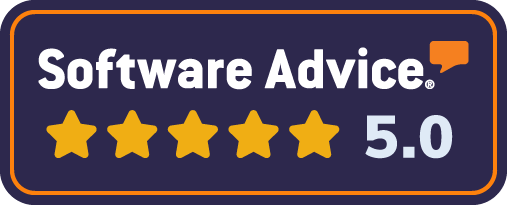SEO analytics tools give you the data you need to measure what’s working and what isn’t in your search strategy. Without proper tracking, you’re flying blind.
At Emplibot, we’ve seen businesses transform their organic performance by focusing on the right metrics. The key is knowing which tools to use and how to interpret the data they provide.
Contents
ToggleEssential SEO Analytics Metrics to Track
Organic Traffic Growth and Sources
Organic traffic growth stands as the most telling indicator of SEO success. Google Analytics reveals that websites tracking organic traffic sources gain valuable performance insights compared to those monitoring only total traffic. Focus on organic sessions from Google, which typically account for 70-80% of total organic traffic for most websites.
Track month-over-month growth patterns rather than daily fluctuations, as search engine algorithms need time to recognize and reward optimization efforts. Monitor traffic sources beyond Google too – Bing delivers 12% of search traffic according to StatCounter, while emerging AI search engines like ChatGPT begin to drive measurable referral traffic.
Keyword Rankings and Performance
Keyword rankings provide the foundation for traffic growth, but tracking individual positions misses the bigger picture. Monitor keyword visibility instead – the percentage of total possible impressions your site captures across all target keywords. Google Search Console shows that pages ranking in positions 1-3 capture significant click share, with top rankings generating 39.8% CTR rates, making top-three visibility your primary goal.

Track click-through rates alongside rankings, as a 5% CTR improvement can double your traffic even without ranking changes. Pages with higher CTRs signal relevance to search engines, which can boost rankings further (creating a positive feedback loop).
User Engagement and Technical Metrics
User engagement metrics like average session duration and bounce rate directly influence rankings according to Backlinko research. Pages with 3+ minute average sessions rank 40% higher than those under 1 minute. These signals tell search engines that users find your content valuable and relevant.
Monitor Core Web Vitals scores monthly, as Google confirmed these technical metrics affect 15% of ranking decisions in their algorithm updates. Site speed, visual stability, and interaction responsiveness now play direct roles in search performance (not just user experience).
The right analytics tools make tracking these metrics simple and actionable, which brings us to the platforms that deliver the most comprehensive insights. Understanding how to measure SEO success and ROI helps you connect these metrics to business outcomes effectively.
Top SEO Analytics Tools for Businesses
Google’s Free Foundation Tools
Google Analytics 4 and Google Search Console form the foundation of professional SEO analytics because they provide first-party data directly from Google’s systems. GA4 tracks user behavior patterns, conversion paths, and traffic sources with cookie-free measurement capabilities that prepare your analytics for privacy changes. Search Console reveals exactly how Google sees your site – it shows impressions, clicks, and average positions for every keyword that triggers your pages in search results.
The combination delivers comprehensive insights: GA4 shows what users do after they click, while Search Console shows why they clicked in the first place. Both tools integrate seamlessly and cost nothing, which makes them essential starting points for any SEO measurement strategy.
Premium Tools That Justify Their Cost
SEMrush and Ahrefs dominate the premium SEO analytics space because they provide competitor intelligence that free tools cannot match. SEMrush excels at content gap analysis and keyword difficulty assessment – it shows you exactly which keywords your competitors rank for that you don’t. Their traffic analytics feature estimates competitor organic traffic with high accuracy according to third-party studies.
Ahrefs maintains the largest backlink database with over 295 billion indexed pages, which makes it superior for link analysis and identification of link opportunities. Ahrefs also updates keyword rankings daily compared to SEMrush’s weekly updates (this gives you faster insights into ranking changes). Both platforms offer API access for custom reports, but Ahrefs provides more granular historical data that goes back 5+ years.
Technical SEO Analysis Requires Specialized Tools
Screaming Frog SEO Spider handles technical audits that general analytics tools miss. It crawls up to 500 URLs for free and identifies critical issues like duplicate content, broken links, and missing meta tags. The tool processes large sites efficiently – it analyzes 50,000 pages in under an hour on standard hardware.

For Core Web Vitals monitoring, PageSpeed Insights and GTmetrix provide real-time performance scores, but Lighthouse CI offers automated tests that integrate with development workflows. These specialized SEO tools catch technical problems before they impact rankings, while general analytics platforms only show the traffic decline after damage occurs.
Once you select the right combination of tools for your needs, the next step involves setting up systematic reports that turn raw data into actionable insights.
How to Set Up Effective SEO Reporting
Effective SEO reports transform scattered data points into actionable business intelligence through systematic dashboard creation and automated monitoring systems. Google Analytics 4 and Search Console data exports provide the foundation, but you combine them with third-party tools like SEMrush or Ahrefs to create comprehensive performance pictures. Build custom dashboards in Looker Studio that connect multiple data sources – organic traffic from GA4, keyword rankings from Search Console, backlink growth from Ahrefs, and technical health scores from PageSpeed Insights. This integration reveals correlations between technical improvements and traffic growth that single-tool reports miss entirely.
Dashboard Architecture That Reveals Performance Patterns
Structure dashboards around business outcomes rather than tool-specific metrics. Create separate views for executives (who focus on traffic growth and conversion impact), content teams (who emphasize keyword performance and content gaps), and technical teams (who highlight Core Web Vitals and crawl errors). Set up automated alerts when organic traffic drops 15% week-over-week or when Core Web Vitals scores fall below Google’s thresholds. These triggers catch problems before they compound into major ranking losses.
Strategic Data Interpretation Beyond Surface Metrics
Raw numbers mean nothing without context and comparison benchmarks. Analyze traffic patterns against seasonal trends, algorithm updates, and competitor movements to identify true performance drivers.

When organic traffic increases 25%, examine which pages and keywords drove growth – this reveals successful content strategies worth replication. Correlate ranking improvements with specific optimization efforts using date ranges that account for Google’s indexing delays. This approach transforms reports from status updates into strategic roadmaps that guide resource allocation and optimization priorities.
Final Thoughts
SEO analytics tools convert guesswork into data-driven strategy. Start with Google Analytics 4 and Search Console for foundational insights, then add premium tools based on your specific needs. Small businesses benefit most from SEMrush’s comprehensive keyword research, while larger enterprises require Ahrefs’ extensive backlink database and API capabilities.
Success depends on consistent measurement of organic traffic growth, keyword performance, and user engagement metrics. Focus on trends rather than daily fluctuations, and connect technical improvements to business outcomes through systematic reports. The most effective approach combines automated alerts with strategic interpretation (this reveals optimization opportunities that drive sustainable growth).
For businesses that want complete automation, Emplibot handles everything from keyword research to content creation and SEO optimization across WordPress and social media platforms. This comprehensive solution saves time while maintains the data-driven approach that successful SEO analytics tools provide. We at Emplibot automate the entire content workflow so you can focus on strategy rather than execution.










